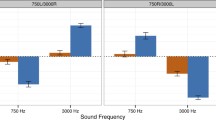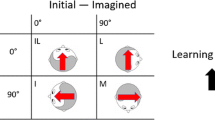Abstract
Participants standing at an origin learned the distance and azimuth of target objects that were specified by 3-D sound, spatial language, or vision. We tested whether the ensuing target representations functioned equivalently across modalities for purposes of spatial updating. In experiment 1, participants localized targets by pointing to each and verbalizing its distance, both directly from the origin and at an indirect waypoint. In experiment 2, participants localized targets by walking to each directly from the origin and via an indirect waypoint. Spatial updating bias was estimated by the spatial-coordinate difference between indirect and direct localization; noise from updating was estimated by the difference in variability of localization. Learning rate and noise favored vision over the two auditory modalities. For all modalities, bias during updating tended to move targets forward, comparably so for three and five targets and for forward and rightward indirect-walking directions. Spatial language produced additional updating bias and noise from updating. Although spatial representations formed from language afford updating, they do not function entirely equivalently to those from intrinsically spatial modalities.






Similar content being viewed by others
References
Amorim MA, Glasauer S, Corpinot K, Berthoz A (1997) Updating an object's orientation and location during nonvisual navigation: a comparison between two processing modes. Percept Psychophys 59:404–418
Andersen RA (1999) Multimodal integration for the representation of space in the posterior parietal cortex. In: Burgess N, Jeffery KJ, O'Keefe J (eds) The hippocampal and parietal foundations of spatial cognition. Oxford University Press, New York, pp 90–103
Bachmann E, Perrig WJ (1988) Die mentale Repräsentation von verbalen Ortsbeschreibungen. Schweizerische. Z Psychol 47:25–36
Beall AC, Blascovich J, Loomis JM (2001) PC-based immersive virtual environment technology as a behavioral science research tool. Unpublished manuscript, University of California, Santa Barbara
Böök A, Gärling T (1981) Maintenance of orientation during locomotion in unfamiliar environments. J Exp Psychol Hum Percept Perform 7:995–1006
Bosco A, Filomena S, Sardone L, Scalisi TG, Longoni AM (1996) Spatial models derived from verbal descriptions of fictitious environments: the influence of study time and the individual differences in visuo-spatial ability. Psychol Beitr 38:451–464
Farah MJ, Wong AG, Monheit MA, Morrow LA (1989) Parietal lobe mechanisms of spatial attention: modality-specific or supramodal? Neuropsychologia 27:461–470
Farrell MJ, Thomson JA (1999) On-line updating of spatial information during locomotion without vision. J Mot Behav 3:39–53
Ferguson EL, Hegarty M (1994) Properties of cognitive maps constructed from texts. Mem Cognit 22:455–473
Francis WN, Kucera H (1982) Frequency analysis of English usage: lexicon and grammar. Houghton Mifflin, Boston
Franklin N, Tversky B (1990) Searching imagined environments. J Exp Psychol Gen 119:63–76
Graziano MS, Gross CG (1998) Spatial maps for the control of movement. Curr Opin Neurobiol 8:195–201
Graziano MS, Reiss LA, Gross CG (1999) A neuronal representation of the location of nearby sounds. Nature 397:428–430
Haber L, Haber RN, Penningroth S, Novak K, Radgowski H (1993). Comparison of nine methods of indicating the direction to objects: data from blind adults. Perception 22:35–47
Klatzky RL, Lippa Y, Loomis JM, Golledge R G (2002) Learning directions of objects specified by vision, spatial audition, or auditory spatial language. Learn Mem (in press)
Loomis JM, Da Silva JA, Fujita N, Fukusima SS (1992) Visual space perception and visually directed action. J Exp Psychol Hum Percept Perform 18:906–921
Loomis JM, Klatzky RL, Philbeck JW, Golledge RG (1998) Assessing auditory distance perception using perceptually directed action. Percept Psychophys 60:966–980
Loomis JM, Lippa Y, Klatzky RL, Golledge RG (2002) Spatial updating of locations specified by 3-D sound and spatial language. J Exp Psychol Learn Mem Cogn 28:335–345
Montello DR, Richardson AE, Hegarty M Provenza M (1999) A comparison of methods for estimating directions in egocentric space. Perception 28:981–1000
Ooi TL, Wu B, He ZJ (2001) Distance determined by the angular declination below the horizon. Nature 4:97–200
Perrig W, Kintsch W (1985) Propositional and situational representations of text. J Mem Lang 24:503–518
Philbeck JW, Loomis JM, Beall AC (1997) Visually perceived location is an invariant in the control of action. Percept Psychophys 59:601–612
Philbeck JW, Klatzky RL, Behrmann M, Loomis JM, Goodridge J (2001) Active control of locomotion facilitates nonvisual navigation. J Exp Psychol Hum Percept Perform 27:141–153
Presson CC, Montello DR (1994) Updating after rotational and translational body movements: coordinate structure of perspective space. Perception 23:1447–1455
Rieser JJ (1989) Access to knowledge of spatial structure at novel points of observation. J Exp Psychol Learn Mem Cogn 15:1157–1165
Rieser JJ, Rider EA (1991) Young children's spatial orientation with respect to multiple targets when walking without vision. Dev Psychol 27:97–107
Taylor HA, Tversky B (1992) Descriptions and depictions of environments. Mem Cogn 20:483–496
Thomson JA (1983) Is continuous visual monitoring necessary in visually guided locomotion? J Exp Psychol Hum Percept Perform 9:427–443
Thompson WL, Kosslyn SM (1999) Neural systems activated during visual mental imagery. In: Toga AW, Mazziotta JC (eds) Brain mapping: the systems. Academic, San Diego, pp 535–560
Wang RF (1999) Representing a stable environment by egocentric updating and invariant representations. Spat Cogn Comput 1:431–445
Wang RF, Spelke ES (2000) Updating egocentric representations in human navigation. Cognition 77:215–250
Wilson PN, Tlauka M, Wildbur D (1999) Orientation specificity occurs in both small- and large-scale imagined routes presented as verbal descriptions. J Exp Psychol Learn Mem Cogn 25:664–679
Acknowledgements
This research was supported by National Eye Institute grant EY09740. A preliminary report of this work was reported at the 2001 Annual Meeting of the Psychonomic Society in Orlando, Florida. We thank Jerome Tietz for constructing the set up in experiment 2, Mike Kinsella for running participants in experiment 1, and Eyal Aharoni and Max Krasnow for helping to run participants in experiment 2. We also thank the reviewers.
Author information
Authors and Affiliations
Corresponding author
Rights and permissions
About this article
Cite this article
Klatzky, R.L., Lippa, Y., Loomis, J.M. et al. Encoding, learning, and spatial updating of multiple object locations specified by 3-D sound, spatial language, and vision. Exp Brain Res 149, 48–61 (2003). https://doi.org/10.1007/s00221-002-1334-z
Received:
Accepted:
Published:
Issue Date:
DOI: https://doi.org/10.1007/s00221-002-1334-z




